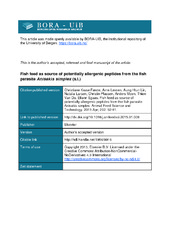| dc.contributor.author | Fæste, Christiane Kruse | eng |
| dc.contributor.author | Levsen, Arne | eng |
| dc.contributor.author | Lin, Aung Htun | eng |
| dc.contributor.author | Larsen, Natalie | eng |
| dc.contributor.author | Plassen, Christin | eng |
| dc.contributor.author | Moen, Anders | eng |
| dc.contributor.author | Do, Thien Van | eng |
| dc.contributor.author | Egaas, Eliann | eng |
| dc.date.accessioned | 2015-05-28T07:46:55Z | |
| dc.date.available | 2015-05-28T07:46:55Z | |
| dc.date.issued | 2015-04 | |
| dc.identifier.issn | 0377-8401 | en_US |
| dc.identifier.uri | http://hdl.handle.net/1956/9916 | |
| dc.description.abstract | The carry-over of certain feed components into animal products can be of concern for human health. The safety assessment of chemical contaminants including natural toxins, agrochemicals, veterinary drugs, and environmental pollutants is a key element of the “farm-to-fork” (“One Health”) approach. The transmissibility of proteinaceous feed constituents such as enzymes, proteins from genetically engineered crops, and infectious prions in animal meal has also become of interest; but the transfer of proteins with allergic potential is little studied. In the present study, an exploratory zebrafish feeding trial using feed containing 20 percent of processed larvae of the marine fish parasite Anisakis simplex was performed as a proof-of-principle experiment. After a 2-week exposure period, anisakid peptides were detected in zebrafish tissue by high-resolution liquid-chromatography Orbitrap mass spectrometry and immunostaining using specific polyclonal antibodies or sera from patients with confirmed allergy to A. simplex. Since fishmeal produced from marine pelagic fish is an important feed component in the culture of Atlantic salmon and in the poultry industry, it should be considered as a source of potentially allergenic peptides in the final products. Furthermore, the substitution of fishmeal with plant proteins would not eliminate the potential health risk by allergen carry-over since crops of high nutritional value such as legumes also contain important food allergens. If our preliminary results from the present zebrafish feeding trial should be confirmed in necessary follow-up experiments, the question of labeling information on fish and animal food products raised on feed containing potentially allergenic ingredients could arise in order to minimize the exposure risk of allergic consumers. | en_US |
| dc.language.iso | eng | eng |
| dc.publisher | Elsevier | en_US |
| dc.relation.ispartof | <a href="http://hdl.handle.net/1956/9895" target="_blank">IgE sensitization to the fish parasite Anisakis simplex in Norway</a> | en_US |
| dc.rights | Copyright 2015 Elsevier B.V. | eng |
| dc.rights.uri | http://creativecommons.org/licenses/by-nc-nd/4.0/ | eng |
| dc.subject | Feeding trial | eng |
| dc.subject | Zebrafish (Daniorerio) | eng |
| dc.subject | Peptide transmissibility | eng |
| dc.subject | Allergenic peptides | eng |
| dc.subject | Anisakis simplex | eng |
| dc.title | Fish feed as source of potentially allergenic peptides from the fish parasite Anisakis simplex (s.l.) | en_US |
| dc.type | Peer reviewed | |
| dc.type | Journal article | |
| dc.description.version | acceptedVersion | en_US |
| dc.identifier.doi | https://doi.org/10.1016/j.anifeedsci.2015.01.006 | |
| dc.source.journal | Animal Feed Science and Technology | |
| dc.source.40 | 202 | |
| dc.source.pagenumber | 52-61 | |

